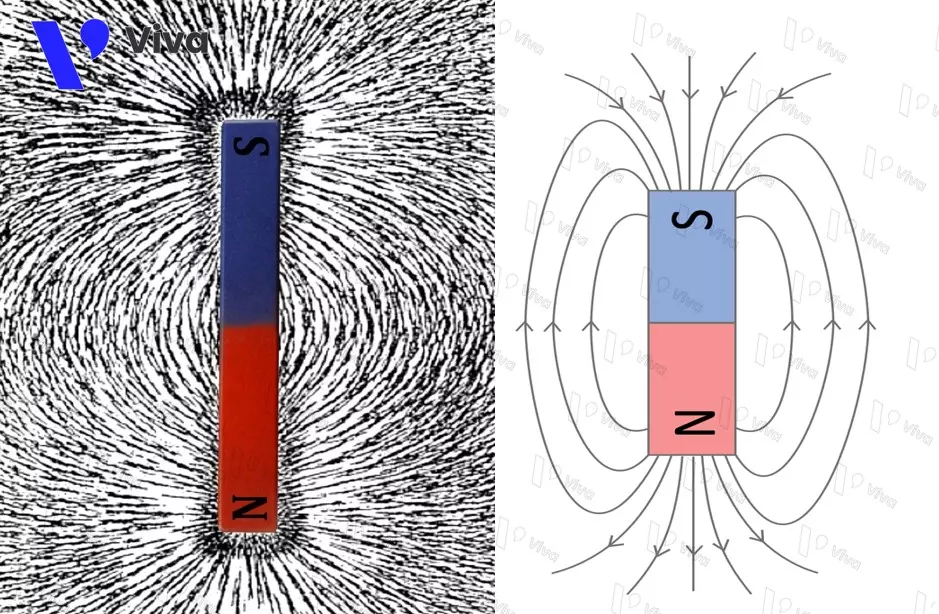Magnetic field
In our daily lives, we often encounter phenomena that are not visible to the naked eye but have a powerful impact on the surrounding environment. One of these phenomena is the magnetic field.
The magnetic field is not only a concept in physics but also of great importance in life and many other scientific fields.
A magnetic field can be generated by electric currents or magnets. In addition, there always exists a very large magnetic field around us (the Earth’s magnetic field), leading to various effects. In this article, we will explore more deeply the concept of the magnetic field, how it is created, and its impact.
What is a magnetic field?
A magnetic field is a space that exists around a magnet, an electric current, or even the Earth. The magnetic field cannot be observed with the naked eye and is not a material medium. If we place a magnet in a vacuum, it still has a magnetic field around it.
Materials with magnetism placed in a magnetic field will experience force interactions (either attracting or repelling forces).
For convenience in calculation and research, the magnetic field is represented by a field of vectors. These vectors represent the strength and direction of the forces acting on magnets, electric currents, magnetic materials, and charges within the space where the magnetic field is generated.
To assess the strength or weakness of the magnetic field at a specific point and its potential impact and interaction with other objects in space.

Magnetic Field Strength
To represent the strength or weakness of a magnetic field at a specific position, we use the quantity “magnetic field strength,” often denoted as B, and
In the International System of Units (SI), the unit of measurement for magnetic field strength is the Tesla (T), named after the Serbian-American physicist Nikola Tesla. One Tesla is equivalent to one Weber per square meter (1 T = 1 Wb/m²).
Additionally, the unit of measurement for magnetic field strength commonly used is the Gauss (G), especially in certain fields such as medicine and location determination. The relationship between Tesla and Gauss is: 1 T = 10,000 G.
A magnetic field with high strength will have a stronger impact on magnetic materials or electronic systems. The magnetic field strength can also vary in space, decreasing in intensity as the distance from the source of the magnetic field increases.
History of Magnetic Field Research
As you may know, our Earth is like a giant magnet, and there is always a vast magnetic field surrounding it. The awareness of the magnetic field originates from the observation of phenomena related to magnetic stones that exist in nature.
The history of magnetic field research can be divided into the following stages:
- Ancient Greek thinkers, such as Thales of Miletus and later Pythagoras, observed that a type of naturally occurring mineral called magnetite (lodestone) had the ability to attract iron.
- Ancient Chinese and Indian civilizations also recognized the properties of magnets and used them for various purposes.
- In the 13th century, European scholars, including Peter Peregrinus and William Gilbert, conducted systematic experiments and observations on magnets and magnetic phenomena.
- Gilbert’s work in the late 16th century laid the foundation for scientific understanding of magnetism. He coined the term “magnet” and proposed that the Earth itself acts as a giant magnet.
- In the early 19th century, Hans Christian Orsted observed that a compass needle deflected when placed near a conductor carrying an electric current, establishing a connection between electricity and magnetism.
James Clerk Maxwell developed a unified theory of electricity and magnetism. He formulated the mathematical equations known as Maxwell’s equations, which describe the behavior of electric and magnetic fields and their interactions. - In the early 20th century, quantum mechanics revolutionized the understanding of the micro world, including the behavior of electrons and their interactions with magnetic fields.
- The theory of quantum fields provided a framework to describe electromagnetic fields as quantum particles called photons.
- The development of technologies such as electromagnets, generators, transformers, and electric motors in the 19th and 20th centuries expanded the practical applications of magnetic fields. Modern research continues to explore magnetic fields and their applications in various fields, including medicine (MRI), electronics, power generation, and particle physics.
Understanding of the magnetic field has evolved through the contributions of many scientists over centuries. It is a field of ongoing research, and new discoveries continue to enhance our knowledge of magnetic fields.

How is a Magnetic Field Created?
A magnetic field is created by the movement of electric charges. All matter is composed of atoms, each of which has a nucleus made up of neutrons and protons with electrons moving around the nucleus.
Since the moving electrons around the nucleus are small electric charges in motion, a small magnetic field is created around each atom. These magnetic fields have a specific orientation or direction, known as the atomic magnetic moment. Thus, each atom can be seen as a tiny magnet. In an object with many different atoms, these magnets create magnetic fields with random orientations, resulting in their mutual cancellation. As a result, in reality, most natural substances have a magnetic field of zero.
In some special cases, certain materials have molecules arranged in such a way that the electrons move in the same direction. In these cases, a magnetic field is created, and the material becomes a magnet. Another example is when an electric current flows through a conductor, and the free electrons move in one direction (at that moment), creating a magnetic field around the wire.

Some Common Types of Magnetic Fields
Magnetic Field of a Magnet
Magnets create a magnetic field by arranging their atoms and electrons in a special structure. The magnetic field of a magnet can attract or repel objects that contain magnetic material.
We can identify it by placing an object with magnetic material (such as another magnet or a piece of iron) within the range of the magnet’s magnetic field. If the object is a positive magnetic field, it will be attracted to the magnet, and vice versa if it is a negative magnetic field.
The strength of the magnetic field of a magnet depends on the properties and shape of the magnet. The magnetic field intensity of a magnet can be enhanced by using special materials and optimizing the design to create a stronger magnetic field.
The magnetic field of a magnet has many applications in electronics, motors, speakers, medical treatments, and various other fields.

Magnetic Field of Current in a Conductor
When there is an electric current flowing through a conductor, it creates a magnetic field around the wire. This is an important phenomenon in physics and is applied in technology and electronic devices.
According to Ampere’s law, the magnetic field created by a straight conductor can be determined by the following formula:
B = (μ₀ * I) / (2π * r)
Where:
- B is the magnitude of the magnetic field at a specific point in space (unit: tesla, T).
- μ₀ is the permeability constant of vacuum (4π x 10^-7 T·m/A).
- I is the current intensity flowing through the conductor (unit: ampere, A).
- r is the distance from that point to the conductor (unit: meter, m).
The above formula applies only to a straight conductor with a linear shape. For complex conductor shapes, the magnetic field intensity depends on the shape and arrangement of the conductor.
The direction of the magnetic field around the conductor is determined by the right-hand rule. When you point your thumb in the direction of the current in the conductor, the other fingers will indicate the direction of the magnetic field around the conductor.

Earth’s Magnetic Field
The Earth’s magnetic field, also known as the geomagnetic field, is a magnetic field that surrounds the Earth. It creates a region of space with a magnetic field, playing an important role in protecting the Earth from high-energy solar radiation and the impact of solar winds.
The geomagnetic field is generated by the geodynamo phenomenon within the Earth’s core. This core contains magnetic field-generating metals, such as iron and nickel in a liquid state, which move due to the effects of temperature and the Coriolis force. The movement of the liquid generates electric currents that sustain the magnetic field.
The orientation of the geomagnetic field is not perfectly aligned with the Earth’s rotational axis. It is not completely symmetrical, and the geomagnetic axis deviates from the rotational axis by about 11.5 degrees. The North Magnetic Pole of the geomagnetic field is located near the geographic North Pole of the Earth, and the South Magnetic Pole is located near the geographic South Pole of the Earth.
The intensity of the geomagnetic field varies across the Earth’s surface and is measured in units of nanoTesla (nT). The average intensity of the geomagnetic field is about 25,000 to 65,000 nT. This intensity can vary depending on the geographic location and changes over time.

Applications of Magnetic Field
Magnetic fields have numerous applications in various fields. Here are some common applications of magnetic fields:
- Industry: In the industrial sector, there are many types of machinery and devices directly related to magnetic fields, such as electromagnetic valves, electromagnetic flow meters, electric motors, generators, etc.
- Medical: Magnetic fields have wide applications in medicine. In medical imaging, such as Magnetic Resonance Imaging (MRI), magnetic fields are used to create layered images of the body for disease detection and diagnosis. Magnetic field-based devices are also used for the treatment of certain medical conditions.
- Electronics and Telecommunications: Magnetic fields are applied in various electronic and telecommunications devices. For example, in speakers, magnetic fields are used to convert electrical currents into sound. In data recording and reading devices, magnetic fields are used in read heads and hard drives.
- Energy: Magnetic fields are used in devices for generating and transmitting energy. For instance, in power generators, magnetic fields are used to produce electricity in coils. In wireless power transfer devices like wireless chargers, magnetic fields are utilized to transmit energy from the source to the device.
- Scientific Research: Magnetic fields are employed in scientific research to study and explore physical phenomena. For example, magnetic fields are used in geophysical survey devices. Magnetic field instruments are also used in materials research and nuclear physics studies.
These are just a few examples of the applications of magnetic fields. In reality, magnetic fields have many other applications, ranging from everyday household appliances to complex industrial and scientific devices.

Questions Related to Magnetic Field
Does the magnetic field of a permanent magnet diminish over time?
In reality, a permanent magnet can lose some of its magnetic field over time, but it doesn’t completely disappear. The process of losing magnetic field in a permanent magnet is called natural demagnetization.
There are several factors that can cause natural demagnetization in a permanent magnet, including:
- Temperature: High temperatures can reduce the magnetic field of a magnet. Permanent magnets typically have a maximum temperature limit at which they can operate without significant loss of magnetic field.
- External magnetic field exposure: Placing a permanent magnet near strong magnetic fields or subjecting it to strong magnetic fields can cause a partial loss of its magnetic field.
- Time factors: Time can also decrease the magnetic field of a permanent magnet through a process known as time-dependent demagnetization. However, this process occurs very slowly, and a permanent magnet can retain its magnetic field for hundreds of years before experiencing significant demagnetization.
Are natural magnets and rare-earth magnets different?
Natural magnets and rare-earth magnets are two types of magnets with many similarities in terms of their nature. Both are permanent magnets.
“A permanent magnet” is a term used to describe magnets that can hold a magnetic field almost indefinitely (although a significant amount of the magnetic field may be lost after hundreds of years) without requiring an external power source to maintain it (unlike electromagnets).
Natural magnets are naturally occurring materials found in nature. They are also known as lodestones and are often encountered in the form of magnetic rocks or horseshoe-shaped magnets, painted in two colors, red and blue.
On the other hand, rare-earth magnets require humans to combine various materials together, such as neodymium (Nd), samarium (Sm), and other related elements.
Rare-earth magnets have a stronger magnetic field intensity compared to natural magnets.

How do we measure magnetic fields?
We can measure magnetic fields using various methods depending on the specific properties and applications we are interested in. Here are some common methods for measuring magnetic fields:
Magnetic field sensors: Using magnetic field sensors such as Hall sensors, quantum sensors, or superconducting sensors to measure magnetic fields. These sensors interact with the magnetic field and generate a measurable electronic signal, allowing us to determine the magnitude and direction of the magnetic field.
Magnetometer: Using a magnetometer to measure magnetic fields. A magnetometer is a device specifically designed to measure magnetic fields, capable of measuring the directional components of the magnetic field in three-dimensional space. Magnetometers can be used to measure the magnetic field of the Earth, magnetic fields in physics research, or in various technological applications.

Why do magnetic fields exist?
According to Ampere’s Law, when an electric current flows through a conductor, it creates a magnetic field around that conductor. This magnetic field can be sensed and measured using tools such as magnetic field sensors.
According to Faraday’s Law, the change in a magnetic field can induce an electromotive force. This means that when there is a change in the magnetic field surrounding a conductor, an electric current will be generated in that conductor.
How does magnetic field impact daily life?
Magnetic fields have various impacts on our daily lives. Here are some important effects of magnetic fields on our daily lives:
- Protection from solar radiation: Earth’s magnetic field creates a protective layer that helps shield a portion of solar radiation, preventing direct contact with Earth’s surface. This helps protect humans from the negative effects of radiation caused by sunlight and high-energy particles from space.
- Orientation and navigation: Earth’s magnetic field plays a crucial role in orientation and navigation. We use compasses, GPS, and other positioning technologies to determine our direction and location based on the magnetic field.
- Technology and electronic devices: Magnetic fields can impact the operation of electronic devices such as computers, mobile phones, cameras, tablets, and various other devices. It can cause interference and affect the signals and functioning of these devices.
- Healthcare and medical imaging: Magnetic Resonance Imaging (MRI) machines utilize strong magnetic fields to create images of the body. MRI is an important tool in medical diagnosis and helps physicians examine anatomy and diagnose diseases.

Summary
In this article, we have discussed magnetic fields – an important and widely applicable concept in the fields of physics, technology, and industry. We have explored the intensity of magnetic fields, the history of research, common types of magnetic fields, applications, and related questions.
As always, I am delighted that this information can be helpful to you in some way, and I warmly welcome any feedback and contributions to further improve the article.
Thank you sincerely!
